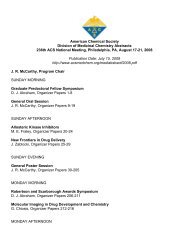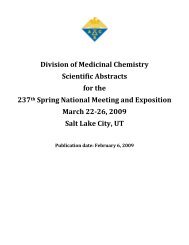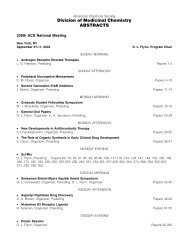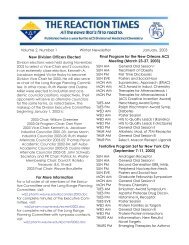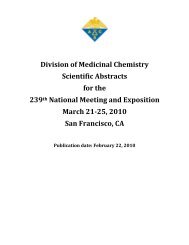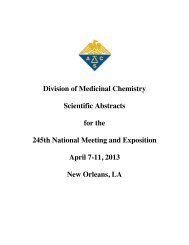Division of Medicinal Chemistry Abstracts-235th ACS National ...
Division of Medicinal Chemistry Abstracts-235th ACS National ...
Division of Medicinal Chemistry Abstracts-235th ACS National ...
- No tags were found...
Create successful ePaper yourself
Turn your PDF publications into a flip-book with our unique Google optimized e-Paper software.
MEDI 86<br />
Targeting RING finger domain <strong>of</strong> HDM2 for cancer therapy<br />
Zengjian Hu and Lei Liu, Department <strong>of</strong> Computer-Aided Drug Discovery, Biogenova, Corp,<br />
401 Rosemont Ave, 3rd Floor, Rosenstock Hall, Frederick, MD 21701<br />
Human double minute 2 (HDM2) is by far the most studied and best understood p53-specific<br />
ubiquitin protein ligase. The C-terminal domain <strong>of</strong> HDM2, critical for its E3 ubiquitin ligase<br />
activity, was identified as the RING finger domain. Recently, a family <strong>of</strong> small molecules has<br />
been identified to inhibit HDM2's E3 activity which does not involve inhibition <strong>of</strong> the p53-HDM2<br />
interaction. Therefore, HDM2 RING finger domain represents a new promising target for<br />
developing anticancer agents. In this study, we use structure-based virtual screening to identify<br />
novel small molecule inhibitors <strong>of</strong> HDM2 by using experimental structure <strong>of</strong> the HDM2 RING<br />
finger domain and our natural products library. The lead compounds from our studies are nonpeptide,<br />
cell permeable small molecules that specifically bind to the RING finger domain <strong>of</strong><br />
HDM2 and will inhibit HDM2's E3 activity. And this inhibition in turn will promote and/or induce<br />
apoptosis in human cancer cells.<br />
MEDI 87<br />
Total synthesis <strong>of</strong> new cytotoxic diterpenes<br />
Daniel Rabouin, Lionel Dumas, Eric Beaulieu, Kenza Daïri, Samuel Fortin, Eric Fournier,<br />
Gerson G. Gonzalez, Sasmita Tripathy, Sylvie Bailly, Gaetan Gagnon, Sandra Naranjo, Brigitte<br />
St-Denis, Nancy Steenaart, Jean-François Lavallee, Giorgio Attardo, Pierre Beauparlant, Xavier<br />
Billot, and Laurent Bélec, Gemin X Biotechnologies Inc, 3576 Avenue du Parc, suite 4310,<br />
Montréal, QC H2X 2H7, Canada, drabouin@geminx.com, ldumas@geminx.com<br />
We identified a diterpene <strong>of</strong> natural origin; (R)-10-hydroxy-6-methoxy-1,1,4a,7-<br />
tetramethylphenanthrene-2,9(1H,4aH)-dione , during a high throughput screening campaign.<br />
This compound induces the activation <strong>of</strong> caspase-3, an apoptotic effector. In an effort to<br />
generate derivatives <strong>of</strong> this compound we devised a synthetic methodology which allowed us to<br />
obtain a first series <strong>of</strong> analogs. In order to target some specifics analogues <strong>of</strong> general structure<br />
1, a modified synthetic route was devised. A series <strong>of</strong> modifications on ring C was achieved by<br />
using a Wittig-Heck approach. We will describe the synthetic approaches used in this project<br />
along with examples <strong>of</strong> biologically active compounds.



